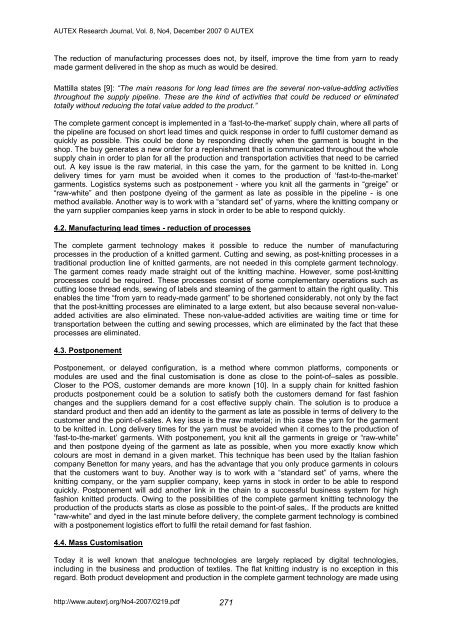production and business methods in the integral knitting supply chain
production and business methods in the integral knitting supply chain
production and business methods in the integral knitting supply chain
You also want an ePaper? Increase the reach of your titles
YUMPU automatically turns print PDFs into web optimized ePapers that Google loves.
AUTEX Research Journal, Vol. 8, No4, December 2007 © AUTEXThe reduction of manufactur<strong>in</strong>g processes does not, by itself, improve <strong>the</strong> time from yarn to readymade garment delivered <strong>in</strong> <strong>the</strong> shop as much as would be desired.Mattilla states [9]: “The ma<strong>in</strong> reasons for long lead times are <strong>the</strong> several non-value-add<strong>in</strong>g activitiesthroughout <strong>the</strong> <strong>supply</strong> pipel<strong>in</strong>e. These are <strong>the</strong> k<strong>in</strong>d of activities that could be reduced or elim<strong>in</strong>atedtotally without reduc<strong>in</strong>g <strong>the</strong> total value added to <strong>the</strong> product.”The complete garment concept is implemented <strong>in</strong> a ‘fast-to-<strong>the</strong>-market’ <strong>supply</strong> cha<strong>in</strong>, where all parts of<strong>the</strong> pipel<strong>in</strong>e are focused on short lead times <strong>and</strong> quick response <strong>in</strong> order to fulfil customer dem<strong>and</strong> asquickly as possible. This could be done by respond<strong>in</strong>g directly when <strong>the</strong> garment is bought <strong>in</strong> <strong>the</strong>shop. The buy generates a new order for a replenishment that is communicated throughout <strong>the</strong> whole<strong>supply</strong> cha<strong>in</strong> <strong>in</strong> order to plan for all <strong>the</strong> <strong>production</strong> <strong>and</strong> transportation activities that need to be carriedout. A key issue is <strong>the</strong> raw material, <strong>in</strong> this case <strong>the</strong> yarn, for <strong>the</strong> garment to be knitted <strong>in</strong>. Longdelivery times for yarn must be avoided when it comes to <strong>the</strong> <strong>production</strong> of ‘fast-to-<strong>the</strong>-market’garments. Logistics systems such as postponement - where you knit all <strong>the</strong> garments <strong>in</strong> “greige” or“raw-white” <strong>and</strong> <strong>the</strong>n postpone dye<strong>in</strong>g of <strong>the</strong> garment as late as possible <strong>in</strong> <strong>the</strong> pipel<strong>in</strong>e - is onemethod available. Ano<strong>the</strong>r way is to work with a “st<strong>and</strong>ard set” of yarns, where <strong>the</strong> knitt<strong>in</strong>g company or<strong>the</strong> yarn supplier companies keep yarns <strong>in</strong> stock <strong>in</strong> order to be able to respond quickly.4.2. Manufactur<strong>in</strong>g lead times - reduction of processesThe complete garment technology makes it possible to reduce <strong>the</strong> number of manufactur<strong>in</strong>gprocesses <strong>in</strong> <strong>the</strong> <strong>production</strong> of a knitted garment. Cutt<strong>in</strong>g <strong>and</strong> sew<strong>in</strong>g, as post-knitt<strong>in</strong>g processes <strong>in</strong> atraditional <strong>production</strong> l<strong>in</strong>e of knitted garments, are not needed <strong>in</strong> this complete garment technology.The garment comes ready made straight out of <strong>the</strong> knitt<strong>in</strong>g mach<strong>in</strong>e. However, some post-knitt<strong>in</strong>gprocesses could be required. These processes consist of some complementary operations such ascutt<strong>in</strong>g loose thread ends, sew<strong>in</strong>g of labels <strong>and</strong> steam<strong>in</strong>g of <strong>the</strong> garment to atta<strong>in</strong> <strong>the</strong> right quality. Thisenables <strong>the</strong> time “from yarn to ready-made garment” to be shortened considerably, not only by <strong>the</strong> factthat <strong>the</strong> post-knitt<strong>in</strong>g processes are elim<strong>in</strong>ated to a large extent, but also because several non-valueaddedactivities are also elim<strong>in</strong>ated. These non-value-added activities are wait<strong>in</strong>g time or time fortransportation between <strong>the</strong> cutt<strong>in</strong>g <strong>and</strong> sew<strong>in</strong>g processes, which are elim<strong>in</strong>ated by <strong>the</strong> fact that <strong>the</strong>seprocesses are elim<strong>in</strong>ated.4.3. PostponementPostponement, or delayed configuration, is a method where common platforms, components ormodules are used <strong>and</strong> <strong>the</strong> f<strong>in</strong>al customisation is done as close to <strong>the</strong> po<strong>in</strong>t-of–sales as possible.Closer to <strong>the</strong> POS, customer dem<strong>and</strong>s are more known [10]. In a <strong>supply</strong> cha<strong>in</strong> for knitted fashionproducts postponement could be a solution to satisfy both <strong>the</strong> customers dem<strong>and</strong> for fast fashionchanges <strong>and</strong> <strong>the</strong> suppliers dem<strong>and</strong> for a cost effective <strong>supply</strong> cha<strong>in</strong>. The solution is to produce ast<strong>and</strong>ard product <strong>and</strong> <strong>the</strong>n add an identity to <strong>the</strong> garment as late as possible <strong>in</strong> terms of delivery to <strong>the</strong>customer <strong>and</strong> <strong>the</strong> po<strong>in</strong>t-of-sales. A key issue is <strong>the</strong> raw material; <strong>in</strong> this case <strong>the</strong> yarn for <strong>the</strong> garmentto be knitted <strong>in</strong>. Long delivery times for <strong>the</strong> yarn must be avoided when it comes to <strong>the</strong> <strong>production</strong> of‘fast-to-<strong>the</strong>-market’ garments. With postponement, you knit all <strong>the</strong> garments <strong>in</strong> greige or “raw-white”<strong>and</strong> <strong>the</strong>n postpone dye<strong>in</strong>g of <strong>the</strong> garment as late as possible, when you more exactly know whichcolours are most <strong>in</strong> dem<strong>and</strong> <strong>in</strong> a given market. This technique has been used by <strong>the</strong> Italian fashioncompany Benetton for many years, <strong>and</strong> has <strong>the</strong> advantage that you only produce garments <strong>in</strong> coloursthat <strong>the</strong> customers want to buy. Ano<strong>the</strong>r way is to work with a “st<strong>and</strong>ard set” of yarns, where <strong>the</strong>knitt<strong>in</strong>g company, or <strong>the</strong> yarn supplier company, keep yarns <strong>in</strong> stock <strong>in</strong> order to be able to respondquickly. Postponement will add ano<strong>the</strong>r l<strong>in</strong>k <strong>in</strong> <strong>the</strong> cha<strong>in</strong> to a successful <strong>bus<strong>in</strong>ess</strong> system for highfashion knitted products. Ow<strong>in</strong>g to <strong>the</strong> possibilities of <strong>the</strong> complete garment knitt<strong>in</strong>g technology <strong>the</strong><strong>production</strong> of <strong>the</strong> products starts as close as possible to <strong>the</strong> po<strong>in</strong>t-of sales,. If <strong>the</strong> products are knitted“raw-white” <strong>and</strong> dyed <strong>in</strong> <strong>the</strong> last m<strong>in</strong>ute before delivery, <strong>the</strong> complete garment technology is comb<strong>in</strong>edwith a postponement logistics effort to fulfil <strong>the</strong> retail dem<strong>and</strong> for fast fashion.4.4. Mass CustomisationToday it is well known that analogue technologies are largely replaced by digital technologies,<strong>in</strong>clud<strong>in</strong>g <strong>in</strong> <strong>the</strong> <strong>bus<strong>in</strong>ess</strong> <strong>and</strong> <strong>production</strong> of textiles. The flat knitt<strong>in</strong>g <strong>in</strong>dustry is no exception <strong>in</strong> thisregard. Both product development <strong>and</strong> <strong>production</strong> <strong>in</strong> <strong>the</strong> complete garment technology are made us<strong>in</strong>ghttp://www.autexrj.org/No4-2007/0219.pdf 271
















